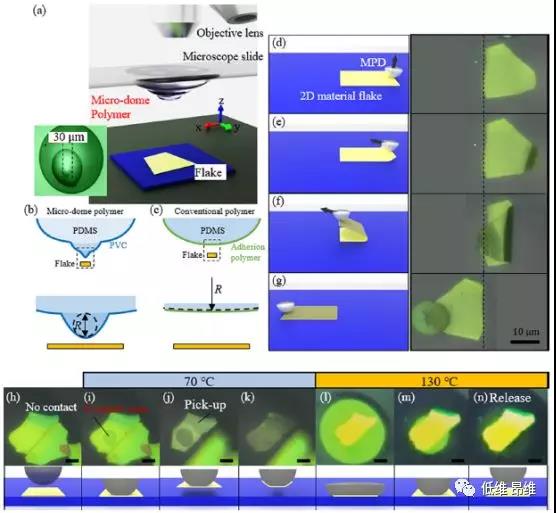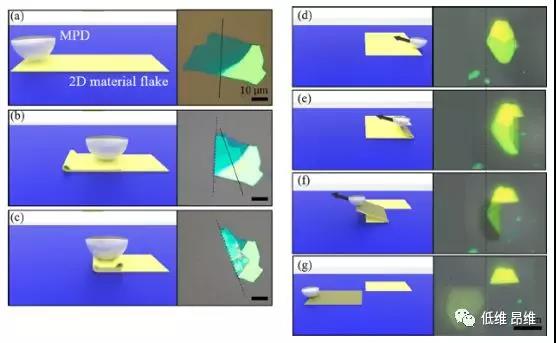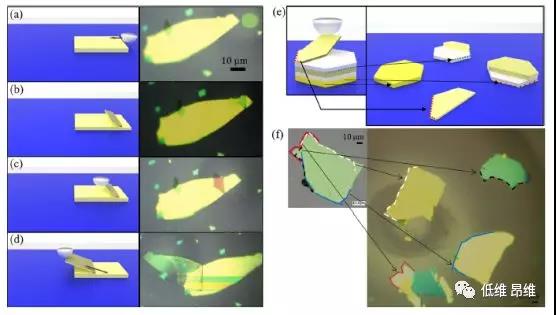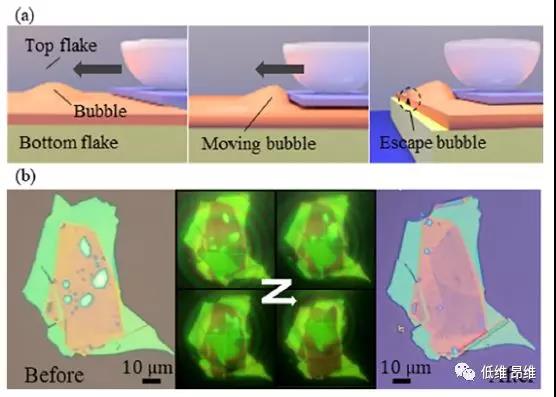
hotline:
17715390137
Tel/Wechat:
18101240246 (Technology)
0512-68565571
Email:mxenes@163.com (Sales Engineer)bkxc.bonnie@gmail.com
Scan the code to follow or search the official account on WeChat:
2D Materials Fronrier After paying attention,
click on the lower right corner to contact us,
Enter enterprise WeChat.
Professional Services Online

Research Background
Van der Waals (vdW) heterojunctions based on different 2D materials have demonstrated many strange phenomena in nanoscale science and technology. Unlike other materials, 2D materials can be stacked by vdW force. Therefore, heterojunctions can be prepared by eliminating lattice mismatch restrictions and interfacial reactions. The construction of this vdW heterojunction is achieved by a transfer method. In this method, the stripped 2D material sheet is first processed on a polymer or substrate, and then transferred directly to another 2D material or by another A 2D material pickup. As the development of basic science and device applications, various types of high-quality vdW heterojunctions have been demonstrated. So far, almost all available fabrication techniques are based on simple pick and release operations on 2D materials. However, recent advances in the assembly of vdW heterojunctions require more complex modes of operation of 2D materials. Specifically, 3D operations of 2D materials must be developed, such as sliding, rotating, and folding. This complex mechanical operation of 2D materials provides a way to fine-tune the vdW heterojunction, so the position of the 2D material in the vdW heterojunction can be modified even after transfer. In the end, 2D materials-based origami and paper-cut preparation technologies can be developed to explore new features of 2D materials.
Achievements
In view of this, recently, Rai Moriya and Tomoki Machida (co-corresponding author) at the University of Tokyo in Japan reported on the use of micro-arch polymers (MDP) to perform 3D mechanical operations of in-situ real-time observation of 2D materials through optical microscopes. Examples include sliding, rotating, folding, flipping, and peeling . The PDMS-based MDP is covered with a PVC adhesive layer. This structure enables a small and fully adjustable contact area between the PVC-MDP and the 2D material sheet. At the same time, the adhesion between the PVC polymer and the 2D material can be adjusted with temperature: it has strong adhesion at about 70 ℃ and can pick up 2D materials; when the adhesion is weak at about 130 ℃, it will Free material. Therefore, PVC-MDP can act as a point-contact manipulator of 2D materials to achieve 3D manipulation, which will promote the expansion of van der Waals heterojunction fabrication technology and the development of more complex 3D structures. The article was published in the famous journal Nano Lettersunder the title of " 3D Manipulation of 2D Materials Using Microdome Polymer " .
Graphic guide

Figure 1. (a) Schematic illustration of MDP micromanipulation of two-dimensional materials. (B) Schematic diagram of MDP structure. (C) A schematic diagram of a conventional transfer method. (Dg) Schematic diagram of flipping a 2D material sheet. (D) The MDP comes into contact with the edge of the sheet when the substrate temperature Ts = 70 ° C.The strong adhesion between the MDP and the 2D material sheet means that the edges of the sheet can be picked up by the MDP from the substrate. (E & f) Move the platform while the edges of the sheet remain adhered to the MDP, gradually peeling the sheet from the substrate. (G) Finally, the edge of the sheet was released by the MDP, and the sheet was dropped on the substrate at Ts = 130 ° C. (Hn) Optical micrographs (top) and schematic (bottom) of PVC-MDP pickup and subsequent release.
Here, in situ 3D manipulation of 2D materials using micro-arch polymers (MDP) is demonstrated. A schematic of this concept is given in Figure 1a. MDP consists of a stack of PDMS polymer structures, as shown in Figure 1b. By successively dropping and solidifying smaller and smaller liquid PDMS droplets, an arched polymer structure with low curvature on the order of tens of microns can be obtained. The contact area between the polymer and the 2D material is about 10 microns (diameter). In addition, a layer of PVC is used to cover the MDP, serving as an adhesion layer for 2D materials. PVC is a polymer with a glass transition temperature of Tg ≈ 90 ℃ and a melting point of Tm ≈ 180 ℃. At the working temperature of ~ 70 ℃, it can adhere very firmly to 2D material sheets, and at ~ 130 ℃ At times, this adhesion is small and negligible, which facilitates the release of the sheet from the PVC. The small contact area with MDP and the strong adhesion of PVC can demonstrate the point-contact pick-up and release operations of 2D materials, thus providing a versatile tool for sheet processing.
Compared to existing polymers used for transfer, PVC-coated MDP (PVC-MDP) has clear advantages. As shown in FIG. 1c, the polymer generally used for transfer requires a contact area larger than the sheet size, because the entire surface of the 2D material sheet must be in contact with the polymer, making it difficult to achieve 3D manipulation. Integrating the PVC-MDP manipulation process with optical microscope observation can realize real-time observation in situ. Figures 1d-g show examples of MDP flipping 2D materials. First, the edge of the sheet is picked up by the PVC-MDP (Figure 1d). Subsequently, the substrate table is moved while the edge of the sheet remains adhered to the MDP, and the sheet is peeled from the substrate (Figures 1e and f). Finally, the 2D material is flipped by releasing the picked sheet onto the substrate (Figure 1g).
In order to test the function of PVC-MDP, the pick-up and release of 2D material flakes are demonstrated, as shown in Figures 1h-n. As shown in Figures 1h and i, PVC-MDP approaches the target h-BN sheet and forms a small circular contact area with the target sheet. By adjusting the distance between the MDP and the target sheet, the contact area can be fully adjusted within a diameter range of approximately 10-200 μm. In Figure 1i, the contact area is controlled at ~ 10 μm when the substrate temperature Ts = 70 ° C. Next, the MDP and the substrate are separated by moving the substrate table downward. Due to the strong adhesion between the PVC-MDP and the sheet, the sheet can be picked up from the substrate even if their contact area is small, as shown in Figures 1j and k. The released sheet is released at a higher temperature, at which the adhesion between the PVC-MDP and the 2D material is greatly reduced. As shown in Figure 11, the 2D material attached to the MDP dome is in contact with the substrate at Ts = 130 ° C, and then the sheet can be released from the MDP (Figures 1m and n).

Figure 2. Schematic and optical micrograph of (ac) h-BN sheet folding.The thickness of the lamella is between 25-40 nm, depending on the location. (A) The PVC-MDP is in contact with one of the edges of the sheet. (B) The edges are picked up by PVC-MDP, moved over the center of the sheet, and released. In this way, the sheet folding operation is completed. (C) After the first full folding operation, the sheet is picked up again by the PVC-MDP and folded again. (Dg) Schematic and optical micrographs of tearing of h-BN flakes about 60 nm thick. (D) PVC-MDP picks up a corner of the sheet at Ts = 70 ° C. (E & f) Moving the pick angle to the left will cause the sheet to tear. (G) After tearing, the pick-up portion of the sheet is released onto the substrate at Ts = 130 ° C. The difference between the tearing and folding operations is the size of the contact area between the MDP and the sheet.
First, we demonstrated the folding and cutting of 2D materials, as shown in Figure 2. Picking the edge of the h-BN sheet and releasing it to the center of the sheet enables folding of the 2D material (Figure 2a-c). PVC has high mechanical strength. After contacting with the substrate or sheet for many times, the surface adhesion has hardly changed. Therefore, 3D manipulation can be repeated without any cleaning or replacement of the PVC polymer. In addition, by further reducing the contact area of the PVC-MDP and picking up the corners of the sheet, a tearing operation on a 2D material can be demonstrated, as shown in Figures 2d-g. In Figure 2d, it can be observed that moving the pick edge of the sheet in a direction perpendicular to the sheet edge causes the sheet to split. The difference between this operation and the folding operation shown in Figs. 2a-c is that picking up only a small portion of the edge is beneficial for sheet tearing, while adhesion of a larger proportion of the edge to the MDP results in folding. This folding process of vdW heterojunctions is critical for periodic vdW stacking or exploring quantum transport in high-quality curved graphene through repeated folding operations.

Figure 3. (ad) Schematic of peeling of a 40 nm thick h-BN sheet. (A) The area of PVC-MDP slightly beyond the edge of the target sheet at Ts = 70 ° C is in contact with the substrate. Then, move the MDP to the left and rub the upper corners with PVC-MDP. (B) Repeating this process will eventually peel the top corner of the sheet upward. (C & d) The peeled part of the sheet is fixed by the MDP, while the latter is moved away from the edge. (E) A schematic diagram of repeated peeling of a 2D material.(F) Optical micrograph showing a single thick h-BN flake and four h-BN flakes peeled from it in sequence.
Further modification of the 2D material flip operation can demonstrate in-situ peeling of the 2D material, as shown in Figures 3a-d. First, gently rubbing the corners of the sheet with PVC-MDP can peel off the edge of the sheet (Figure 3a and b). After that, the strong adhesion between the PVC-MDP and the sheet was able to pick up the peeled part of the sheet until it was completely peeled off (Figure 3c and d). After repeated contact between the PVC-MDP and the substrate or sheet, there is almost no change in its adhesion ability, so the peeling operation can be repeated multiple times, as shown in Figures 3e and f. Here, a single thick h-BN sheet was peeled 3 times and divided into four different sheets. Real-time observation provides useful clues to the mechanism behind the 2D material peeling process, and is expected to achieve the peeling of at least one layer of a single layer.

Figure 4. (a & b) A schematic and optical micrograph of a slip operation on a 2D material. First translate the small slice (red square) along the large substrate slice (yellow square). (A) At Ts = 70 ° C, the small sheet comes into contact with the MDP, and then the MDP moves in the lateral direction. (B) The small sheet moves with the MDP, while the large sheet does not move. (Ce) Schematic and optical micrographs of the rotation operation. (F & g) Schematic and optical micrographs of the process of constructing a cantilever beam structure by translating the h-BN sheet to the side of the substrate. (H) SEM image of the fabricated cantilever structure.
Next, a method for lateral 2D manipulation of 2D materials using PVC-MDP is demonstrated. Figure 4a shows a thin sheet of 2D material on a large-sized thick h-BN substrate. Since the contact area with the PVC-MDP can be adjusted to be smaller than the area of the thin h-BN, only the upper thin h-BN can be operated without moving the lower thick h-BN, as shown in Figures 4a and b. This operation is very useful for fine adjustment of the wafer position during vdW heterojunction preparation. In addition to sliding, as shown in Fig. 4c-e, through the contact between the MDP and the side of the sheet, the sheet can be rotated using PVC-MDP. Here, the preparation of a free-standing 2D material cantilever beam is shown, as shown in Figures 4f and g. The left part of the sheet is adhered to the MDP, then the MDP is pushed to the right to slide the sheet, and once it exceeds the edge of the substrate, the 2D sheet can be released by heating. The MDP is only in contact with the left side of the sheet, while the active area used as the cantilever is not in contact with the polymer. Therefore, in principle, the cantilever has no residual organic matter. The SEM image is shown in Figure 4h, and no significant contamination was observed on the cantilever beam.

Figure 5. (a) Schematic representation of the bubble removal process. (B) Optical micrographs taken before and after removal of air bubbles.
Using lateral manipulation technology for 2D material flakes can eliminate bubbles in vdW heterojunctions. The existence of bubbles between different slices in a vdW heterojunction is a common problem, which prevents the realization of device quality homogeneity. Many attempts to remove air bubbles have been reported, such as high temperature annealing, application of unidirectional force during tilted transfer, and AFM cleaning. As shown in Figure 5a, a sharp edge of a 2D material sheet is used as a tool to push bubbles out of another sheet. Optical micrographs show the flakes before and after the bubble removal operation, as shown in Figure 5b. These results demonstrate that a two-dimensional sheet of material can be used as a tool to remove air bubbles from a vdW heterojunction without causing surface damage or destruction.
Summary and outlook
By using MDP, this paper can demonstrate the 3D mechanical operation of 2D materials, such as sliding, rotating, folding, flipping and peeling, under the observation of in-situ real-time optical microscope. By manufacturing a PVC-coated MDP, an adjustable small contact area is achieved between the MDP and the 2D material sheet, with a diameter between 10-100 μm. This PVC-MDP operation function can be easily integrated into the optical microscope system with a motorized platform. This technique of manipulating 2D materials has huge practical potential, which is helpful for the development of van der Waals heterojunction fabrication technology, and thus for more complex 3D structures.
Literature information
3D Manipulation of 2D Materials Using Microdome Polymer
(Nano Lett., 2020, DOI: 10.1021 / acs.nanolett.9b05228)
Literature link:
https://pubs.acs.org/doi/10.1021/acs.nanolett.9b05228
Source of information: low-dimensional

| Reminder: Beijing Beike New Material Technology Co., Ltd. supplies products only for scientific research, not for humans |
| All rights reserved © 2019 beijing beike new material Technology Co., Ltd 京ICP备16054715-2号 |